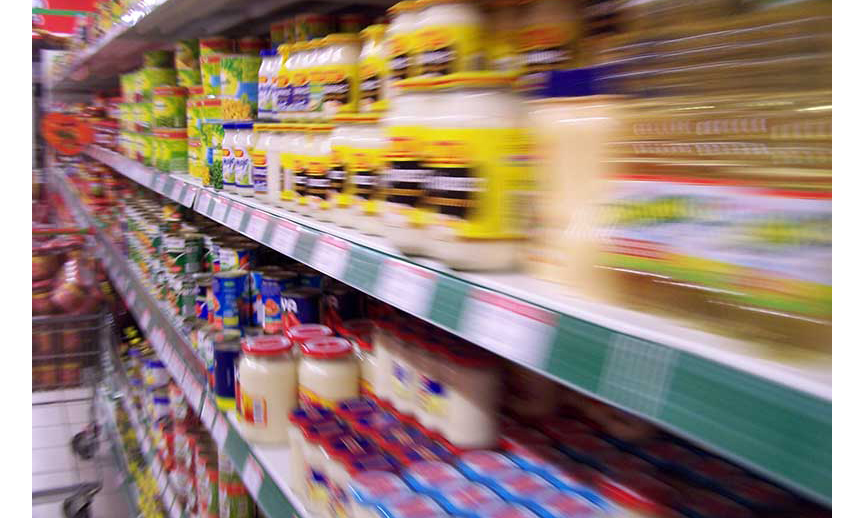by Arielle Kimbarovsky/marketing writer, Crowdspring

The grocery industry brings in over $680 billion in sales every year. In the 1990s, grocery stores carried around 7,000 different products. Today, they carry up to 50,000. This dramatic increase in the number of products on store shelves makes it tough for brands to stand out. Consumers can pick from 15 different types of peanut butter, 50 different cereal brands, dozens of soft drink brands, etc.
Smart brands know that strong food packaging design and package graphics are more important than ever to help brands fight for consumers’ attention. Food packaging helps consumers identify the product (this is also known as package graphics). Often this includes product nutritional labeling. The packaging also helps to protect the products from the environment and to extend the period that the food or drink is safe to consume. Additionally, it enhances the convenience of consuming food and drink. For example, certain milk packaging is much more convenient to store and pour than other milk products. Finally, food packaging is designed to help promote the product and persuade consumers to make a purchase.
With the increasing popularity of online grocery shopping, many brands are forced to rethink how they design packages for maximum impact on a small screen. For companies selling food products, these changes are intimidating. It puts more pressure on the packaging design and increases the need for a good first impression.
If you want to make your products stand out among the 50,000 others lining the shelves, check out our six proven tips for great food packaging.
1. Clarity
When people buy food, they buy what they need. Unless a packaging design catches their eye, most people choose between products that fit their requirements. But most food packaging designs make this choice difficult.
Take juice packaging as an example. There are healthy juices, kid’s juices and sugary juices—often on the same shelves. The packaging typically varies to help consumers identify a sugary kid’s drink from a healthy green blend.
But what happens when another product’s packaging looks similar to a kid’s juice? Consumers become frustrated.
According to a study on consumer judgment and decision making, shoppers can make decisions in about a third of a second. After that brief moment, they’ve already made up their minds—and aren’t happy to find out that they were wrong.
2. Integrity
For consumers to buy your product again, they have to trust your brand. A large part of that trust is keeping the integrity of your product intact. While most brands will edit images of their product for the packaging, some brands will dramatically change how that product looks.
This is a problem for many reasons, but most importantly, it creates a false expectation about the product that the product can never meet.
3. Authenticity
Keep your packaging design consistent with your brand. If your brand is more natural and down to earth, bright primary colors will look out of place and feel fake.
On the other hand, keep an eye out for what competitors are doing. If you aren’t the only brand in your vertical that is natural and earthy, a splash of color might help your product stand out from your competitors’ products.
Being different within the context of your brand is one of the best ways for consumers to feel like they are buying specifically from you.
4. Shelf Impact
Designers and brands aren’t the only ones thinking about food packaging design. Grocery stores and other food retailers constantly think about packaging design and even pay attention to the way that products are displayed on shelves. This is called “shelf impact.”
When grocers consider product placement, they take a look at the way that different packaging designs look together and the patterns that they create. When placing certain products next to each other, the look of the packaging can change. In such cases, sometimes less means more.
When looking at rows of labels, packaging can blend together, and all of the details crammed in on one side of the product can get lost. But if a packaging design stands out enough to get the consumer to pick it up, the consumer is more likely to read other parts of the label.
5. Versatility
It’s important for food packaging designs to be versatile. There’s a reason why the number of products in grocery stores has grown so quickly, and it’s because brands keep expanding their product lines.
With food products, this is as simple as adding a new flavor. But with so many expansions, a different label design for each one is not only more challenging but also more confusing. Instead, the best food packaging designs are adaptable to a variety of products.
6. Usability
Lastly, food product packaging needs to be usable. While it’s easy to only consider the label, the container itself is just as important. Take mayonnaise as an example.
A few years ago, Hellman’s completely revamped their jars, selling mayonnaise out of squeeze bottles to make the product more accessible. Customers were thrilled, but the new bottles still made it hard to get the last of the product out. Hellman’s listened to consumers and designed an even better bottle that squeezed more product out. Russel Lilly, Marketing Director at Hellman’s, says that by focusing on the usability of their product, Hellman’s was able to stand out even more.
One of the best ways that companies and designers can implement these tips is by turning each value into a series of questions.
For example, if you’re looking to tackle clarity, you might ask yourself whether or not you can quickly identify the name, product and benefits of an offering. Then, you might ask yourself if you can easily find the ingredients and expiration date.
On the other hand, if you’re looking at usability, you might ask yourself if the packaging design can be easily stored. You might also ask yourself if the packaging will be able to hold your product and whether or not it can contribute to the product’s shelf life.
No matter which of the values you are trying to implement, focusing on these as a guide can help your food packaging stand out.
Keep reading:
https://www.theshelbyreport.com/2018/04/18/weigels-switching-from-foam-to-paper-hot-cups/
Fiji Water Targets Fitness Enthusiasts With New Sports Cap Bottle

